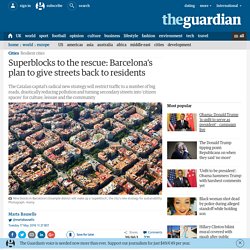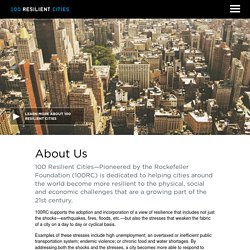

Superblocks to the rescue: Barcelona’s plan to give streets back to residents. In the latest attempt from a big city to move away from car hegemony, Barcelona has ambitious plans.

Currently faced with excessive pollution and noise levels, the city has come up with a new mobility plan to reduce traffic by 21%. And it comes with something extra: freeing up nearly 60% of streets currently used by cars to turn them into so-called “citizen spaces”. The plan is based around the idea of superilles (superblocks) – mini neighbourhoods around which traffic will flow, and in which spaces will be repurposed to “fill our city with life”, as its tagline says. This plan will start in the famous gridded neighbourhood of Eixample. That revolutionary design, engineered by Ildefons Cerdà in the late 19th century, had at its core the idea that the city should breathe and – for both ideological and public health reasons – planned for the population to be spread out equally, as well as providing green spaces within each block.
Rapid Fire V 2 0 Tech Summary. Calthorpe Analytics. New Urbanism. About Us. 100 Resilient Cities—Pioneered by the Rockefeller Foundation (100RC) is dedicated to helping cities around the world become more resilient to the physical, social and economic challenges that are a growing part of the 21st century. 100RC supports the adoption and incorporation of a view of resilience that includes not just the shocks—earthquakes, fires, floods, etc.

—but also the stresses that weaken the fabric of a city on a day to day or cyclical basis. Examples of these stresses include high unemployment; an overtaxed or inefficient public transportation system; endemic violence; or chronic food and water shortages. ATLAS. Producers Group. Imagineer Bob Gurr has always been a man on the move.

And for nearly 40 years, he's helped move many happy Disney theme park guests aboard one of his own designs. As he has often quipped, "If it moves on wheels at Disneyland, I probably designed it. " And he certainly has, developing more than 100 designs for attractions ranging from Autopia to the Matterhorn Bobsleds to the Disneyland and Walt Disney World Monorails, and more.
He attended Art Center College of Design, upon graduation in 1952, he was hired by the Ford Motor Company. In 1954, WED (Walter Elias Disney) Enterprises, today known as Walt Disney Imagineering, hired Bob to consult on design of the mini cars for Autopia. Unlocking the future: The keys to making cities great. More than half the world lives in cities, and that figure is likely to increase to 60 percent by 2030, adding 1.4 billion more people than today.

The rush to urban centers, particularly in emerging economies, is driven by a desire for a better life with more opportunities—as economies start to centralize in cities, so do people. The McKinsey Global Institute (MGI) has estimated that between now and 2025, the world’s urban population will grow by 65 million people a year, or almost 179,000 every day. Meeting the needs of this changing demographic will be challenging.
What has to happen to make a good city? Or a great one? Those are urgent questions. It is worth noting that cities are dynamic environments; they are always works in progress. Given this dynamic, we have identified three things that effective urban leaders do well. 1. Good economic strategy attracts investment. Another critical element is to plan for change. Resilient Cities: Labs of Innovation. One of the most important lessons we’ve learned in the years following Hurricane Katrina is that New Orleans is not unique in its exposure to disasters.

Rising sea levels, droughts, and increased frequency of storms are factors that all cities must now consider when constructing and maintaining built structures. In New Orleans, we took Katrina as an opportunity to rebuild the city—not back to the way she was before, but to the way she should have been. This has positioned New Orleans as one of our nation’s most immediate laboratories for innovation and change. In New Orleans, we can test new ideas, evaluate their impact, and scale successful solutions to other cities. This is exemplified by our partnership with the Rockefeller Foundation through the 100 Resilient Cities Challenge.
Another example of CGI members taking action is Global Green USA, which committed in 2007 to assist Louisiana with green schools policy and outreach. Rise of the Wise: Next Steps for Smart Cities. CGI Latin America will take place in Rio de Janeiro, Brazil, December 8-10.

Watch the live webcast of the meeting in English, Portuguese or Spanish at and join the global conversation online by using the official meeting hashtag #CGI. Latin America is currently the most urbanized region in the world, with nearly 80 percent of its population living in urban centers. Rapid urbanization has brought its problems, and cities must now work to improve their infrastructure and the quality of their public services.
Health, education and social development are challenges that can be met through the judicious implementation of innovative projects and policies. Cities are the natural leaders in this process, because they can help gather multiple interests towards a common goal, and they do so by acting pragmatically at a local level. Smart cities are those who manage their resources efficiently.